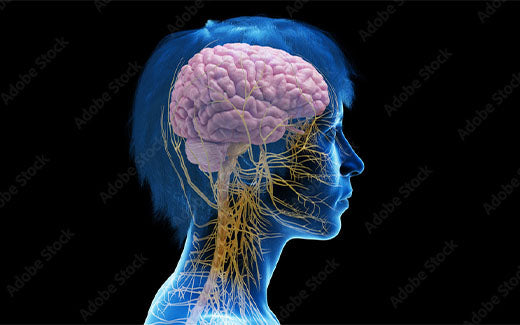Nervous system overview
The role of the nervous system is to rapidly transmit messages around the body in response to internal or external stimuli. The response can be both voluntary movements (known as the somatic nervous system), or involuntary controlling functions like breathing, heart rate or digestion (known as the autonomic nervous system).
The autonomic nervous system is constantly regulating internal functions. The brain receives a signal from a stimulus, the brain then passes the signal on to the body to produce a response. For example, if you become very hot (a stimulus), the autonomic nervous system will increase blood circulation to the skin and produce sweat to cool the body down. The brain also reacts to internal stimuli in the body to produce an effect, such as the stretch receptors in a full bladder telling the brain that the bladder needs emptying. (1)
The autonomic nervous system is made up of three parts, the sympathetic nervous system, the parasympathetic nervous system and the enteric (gastrointestinal) nervous system. The sympathetic and parasympathetic divisions have opposing effects on the body.
Sympathetic nervous system functions
The sympathetic nervous system is a very intelligent in-built system that all humans and animals possess for survival. It is designed to help the body fight or flee to safety from a dangerous or stressful situation, a response which is known as ‘fight or flight’. It is a rapid involuntary response which results in a rush of hormones to change the state in the body to one of heightened awareness and a burst of energy priming the body for action. It results in several instant physiological changes throughout the entire body.
The sympathetic response allows us to react quickly without having to think about it.
According to Harvard medical school (2) these changes happen so quickly that people can initially be unaware of them as the cascade of changes created in the body start to take place before the brains visual centre has had a chance to fully process what is happening. This is why you can move their hand very quickly from a boiling hot surface, or jump out of the way of an oncoming danger before full awareness of the situation.
What is the fight or flight response?
When you face a danger or stressful situation the sensory organs rapidly transmit this information to the amygdala in the brain. This is a part of the brain that processes emotions and will interpret these sensory stimuli and send a distress signal to the hypothalamus. The hypothalamus then sends signals through the autonomic nervous system to the adrenal glands.
The adrenal glands then respond by pumping the hormones adrenaline and cortisol through the blood stream, resulting in physiological changes known as the ‘fight or flight’ response’.
Adrenaline in the blood stream causes the airways in the lungs to dilate so that they can take in more oxygen, extra oxygen is also carried to the brain to increase alertness. Heart rate and blood pressure increases as blood rushes to the muscles and heart. Cortisol triggers the release of stored glucose and fats into the blood stream to supply the body with as much energy as possible. Functions that are not necessary for immediate action such as digestion and reproduction take a back seat. (3)
Fight or flight effects on the body
Some of the effects experienced by the body during a ‘fight or flight response’, depending on the severity of the stimulus are:
- Increased heart rate and blood pressure - breath becomes quicker and heavier, which is helping to move nutrients and oxygen to your muscles and organs priming them for action.
- Dry mouth – digestive processes are halted which includes saliva production.
- Dilated pupils – allowing the eyes to take in more light to see better.
- Feeling tense or trembling –an increase in muscle tensions allows the muscles to move into action at any given moment.
- Feeling on edge – hearing, sight and other senses are heightened as the body looks and listens for dangers.
- Increased alertness – due to a rush of extra oxygen to the brain.
- Loss of bladder control – Loss of voluntary control of the bladder or bowels can occur in truly stressful or dangerous situations as digestive processes are curbed.
What triggers the fight or flight response?
As seen above, the fight or flight response is a survival mechanism that allows you to rapidly run away from a danger or gives you the power to fight it. Any perceived stressors, whether real or not, will create this response within the body.
From an evolutionary perspective, these stressors would have come largely from a threat in the environment. The problem in today’s modern environment is that real physical stressors are far and few between, but perceived stressors can be abundant through constant media stimulation, negative messages through advertising that we aren’t measuring up and much busier lives. People have access to us 24 hours a day and we have little time where we truly switch off.
If stress is not managed and you constantly perceive feeling under attack, the fight or flight reaction is prolonged which can result in chronic stress. After the initial surge of adrenaline, cortisol will still remain elevated in a chronically stressed individual which can result in inflammation, high blood glucose, higher risk of chronic disease and adrenal exhaustion in the long term. Many people can be unaware that they are consistently in this state as it has become their ‘normal’.
Sympathtic vs parasympathetic nervous system
As body functions that aren’t essential to the fight or flight response are temporarily curbed, detrimental effects can be experienced from a constant state of stress, suppressing digestion, altering immune system responses and reproductive functions.
In contrast to sympathetic activation, when the parasympathetic state is dominating, the body is in a relaxed state and returns to the state known as ‘rest and digest’. This mainly occurs via the vagus nerve which is the main component of the parasympathetic nervous system, carrying messages between the organs and digestive tract, and the brain. (4)
Some of the effects of the parasympathetic nervous system include (5):
- Decreased heart rate
- Slower breathing
- A feeling of calmness
- Pupils contract
- Increased digestive processes including saliva production and gut motility
- Reproductive organs may become more responsive
- Modulates inflammation by activating anti-inflammatory pathways
It is important to identify any regular stressors in order to prevent them. However it’s likely there will always be some issues present that you will have to face. This is why it is so important to maintain consistent daily practices that can help you move back to, or maintain, the parasympathetic state. If not managed, chronic stress can lead to depression and anxiety, digestive issues, headaches, weight gain, heart disease, diabetes and more.
Some daily strategies to manage stress include:
- Eating a healthy nutrient dense diet
- Practicing deep breathing, mindfulness or meditation (both when calm and in stressful situations)
- Daily exercise
- Daily daylight exposure
- Getting a good night’s sleep
- Positive and healthy relationships where you can talk to people when needed
- Keeping a gratitude journal
- Doing positive things you enjoy
- Laughter
- Seeking professional counselling if you have persistent stress and anxiety
Conclusion
The sympathetic nervous system is hugely important for your protection and survival.
Some short mild stressors can even be a positive, as research has found that micro stressors such as hot and cold therapy, intermittent fasting, exercise and breath work can actually make us stronger and healthier as an organism (6). This is known as hormesis and this puts the autonomic nervous system to work in the way it’s supposed to, switching on during the stressor and then moving back into the parasympathetic state of ‘rest and digest’ afterwards.
Problems arise when stress is chronic, frequent and long-term. Make it a priority to manage your stress levels using the strategies above to prevent regular long-term stress and in-turn significantly reduce your risk of health issues and feel happier too.
References
1. How does the nervous system work? - InformedHealth.org - NCBI Bookshelf [Internet]. [cited 2022 Aug 18]. Available from: https://www.ncbi.nlm.nih.gov/books/NBK279390/
2. Understanding the stress response - Harvard Health [Internet]. [cited 2022 Aug 18]. Available from: https://www.health.harvard.edu/staying-healthy/understanding-the-stress-response
3. Lee DY, Kim E, Choi MH. Technical and clinical aspects of cortisol as a biochemical marker of chronic stress [Internet]. Vol. 48, BMB Reports. The Biochemical Society of the Republic of Korea; 2015 [cited 2022 Aug 18]. p. 209–16. Available from: /pmc/articles/PMC4436856/
4. Breit S, Kupferberg A, Rogler G, Hasler G. Vagus nerve as modulator of the brain-gut axis in psychiatric and inflammatory disorders [Internet]. Vol. 9, Frontiers in Psychiatry. Frontiers Media S.A.; 2018 [cited 2022 Aug 18]. p. 1. Available from: /pmc/articles/PMC5859128/
5. LeBouef T, Whited L. Physiology, Autonomic Nervous System [Internet]. StatPearls. StatPearls Publishing; 2019 [cited 2022 Aug 18]. Available from: http://www.ncbi.nlm.nih.gov/pubmed/30860751
6. Burbano MSJ, Gilson E. The power of stress: The telo-hormesis hypothesis [Internet]. Vol. 10, Cells. MDPI; 2021 [cited 2022 Aug 18]. Available from: /pmc/articles/PMC8151059/






Share:
What is the circadian rhythm? A complete guide
Stress and the gut-brain axis